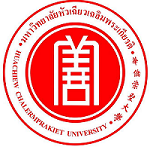กรุณาใช้ตัวระบุนี้เพื่ออ้างอิงหรือเชื่อมต่อรายการนี้:
https://has.hcu.ac.th/jspui/handle/123456789/4609| ชื่อเรื่อง: | 明治维新时期汉语教材《中国话》词汇研究 |
| ชื่อเรื่องอื่นๆ: | การศึกษาวิจัยคำศัพท์จากตำราเรียนภาษาจีน “ภาษาจีน”ในสมัยฟื้นฟูเมจิ A Study on the Vocabulary of the Chinese Textbook "Chinese Language" During the Meiji Restoration Period. |
| ผู้แต่ง/ผู้ร่วมงาน: | 李超 Li Chao 陈潇雅 Chen Xiaoya Huachiew Chalermprakiet University. College of Chinese Studies |
| คำสำคัญ: | ภาษาจีน -- การศึกษาและการสอน Chinese language -- Study and teaching ภาษาจีน -- แบบเรียน Chinese language -- Textbooks ภาษาจีน -- บทสนทนาและวลี Chinese language -- Conversation and phrases ภาษาจีน -- คำศัพท์ Chinese language -- Glossaries, vocabularies, etc. การศึกษาข้ามวัฒนธรรม Cross-cultural studies การวิเคราะห์ทางด้านภาษา Linguistic analysis (Linguistics) 汉语 -- 学习和教学 汉语 -- 教科书 汉语 -- 对话和短语 汉语 -- 词 跨文化教育 |
| วันที่เผยแพร่: | 2024 |
| สำนักพิมพ์: | Huachiew Chalermprakiet University. |
| บทคัดย่อ: | “Chinese Language” is a Chinese textbook in the late Qing Dynasty in China and the Meiji Restoration in Japan. The whole book is mainly in the form of “conversation”, the conversation objects include masters and servants, relatives and friends, etc., the content of conversation includes shopping, loans, housework, church meetings, medical treatment, schooling, etc., and the customs include funerals, sending relatives, buying houses, banquets, rushing to the city, etc., and the language form has distinctive characteristics of the times and has a very strong Beijing dialect color, such as “Your Excellency”, “Therefore”, etc. Through the study of the vocabulary of “Chinese Language”, this paper analyzes the cultural characteristics of its vocabulary, and then puts forward the enlightenment for the major of Chinese as a foreign language. This paper first uses the literature research method, through literature retrieval and review, reading, collecting and sorting out relevant literature materials, and screening out important information for in-depth analysis and thinking through the obtained data, which puts forward a targeted research concept and thesis framework for the writing of the paper, lays a solid foundation for the study of the text, and provides basis and support for the next research of the topic and the writing of the paper. Secondly, statistical analysis and induction are used to sort out the collected data, mainly to transcribe the corpus with research value into data, sort out the high-frequency problems through the data, and classify and count them according to their characteristics, and analyze the data existing in the collected corpus through statistical results and relevant basic theoretical knowledge, and obtain the types and characteristics of problems, so as to provide scientific and reliable support for subsequent conclusions. Complete the classification and statistics of data, summarize and analyze the phenomena reflected in the data, and finally summarize and draw conclusions, and give suggestions from multiple perspectives. Finally, the method of combining synchronic research and diachronic research is used to focus on the longitudinal history of the development process of language from one era to another. In the process of analyzing each content, it is necessary to combine it with diachronic research on the basis of synchronic research, which is conducive to presenting the style of the times behind language and culture. The content of this article is mainly divided into the following six parts: Prolegomenon. It includes the research reasons and significance, research history and current situation, research objects and authors' introductions, research corpus and methods, research focus and difficulties. Chapter 1: An Overview of Chinese Language. It mainly introduces the textbook in detail in terms of the author, background and style of “Chinese Language”. Chapter 2: A Study on the Vocabulary Content and Characteristics of Chinese Language. The characteristics of the times in this book are distinctive, which is manifested in many aspects, and the grammar and topic content embodied in the characteristic phonetics, vocabulary and language basically cover all aspects of daily communication and social life, which is a microcosm of the culture of the time. This paper mainly analyzes and studies the book from the vocabulary aspect. Chapter 3: Cultural Analysis of the Vocabulary of Chinese Language. This paper mainly analyzes and studies the linguistic characteristics, social life and customs of Beijing in the late Qing Dynasty. Chapter 4: The Advantages, Disadvantages and Influence of Chinese Language. As a Chinese textbook with a long history and initial stage, it has its distinctive advantages and inevitable shortcomings, and its influence on modern Chinese teaching textbooks is also obvious. Chapter 5: The Enlightenment of Chinese Language to the Profession of Chinese as a Foreign Language. This paper mainly explores the aspects of textbook compilation, teaching strategies and discipline construction. Epilogue. This paper summarizes the overall research of this paper, including the main research questions, the main points of view, the main innovations of the research, and the future research space. 《中国话》是中国晚清时期,日本明治维新时期的一本汉语教材。全书是以“会话”为主的形式,交谈对象有主仆、亲友等,交谈内容上包括购物、借贷、家务、堂会、求医、设塾等,风俗上有出殡、送亲、买房、宴请、倒赶城等,语言形式上有鲜明的时代特点并且有非常浓郁的北京话色彩,如“阁下”、“故此”等。本文通过对《中国话》词汇的研究,分析其词汇中的文化特色,进而提出对对外汉语专业的启示。本文首先运用文献研究法,通过对文献检索查阅,阅读、搜集和整理相关的文献资料,通过得到的资料,筛选出重要的信息进行深入的分析和思考,为论文的撰写提出了具有针对性的研究概念和论文框架,为文本的研究打下坚实的基础并为课题的下一步研究和论文的撰写提供依据和支持。其次,运用统计分析与归纳法对搜集的资料进行整理,主要是将资料中有研究价值的语料转录为数据资料,借由数据整理出问题高频率的情况,并根据其特征进行分类和统计,通过统计结果,借用相关基础理论知识来对搜集的语料中存在的数据进行分析,得出问题的类型及特点,为后续的结论提供科学可靠的支撑。完成数据的分类和统计,总结和分析数据所反映的现象,最终总结归纳并得出结论,从多角度给出建议。最后,运用共时研究和历时研究相结合的方法,关注语言从一个时代到另一个时代的发展过程的纵向历史的研究。在对每一个内容进行分析的过程中,都需要在共时研究的基础上与历时研究相结合,有利于呈现语言和文化背后的时代风貌。本文内容主要分为如下六个部分:绪论。包括本文的研究理由与意义、研究历史与现状、研究对象与作者简介、研究语料与方法、研究重点与难点。第一章《中国话》的概况。主要是对《中国话》的作者、编写背景和体例等方面对教材进行详细介绍。 第二章《中国话》的词汇内容与特点研究。本书的时代特色鲜明,表现在很多方面上,特色语音、词汇语言上体现的语法和话题内容基本涵盖了日常交际与社会生活的各个方面,是当时文化的一个缩影。本文主要从词汇方面对这本书进行分析和研究。第三章《中国话》词汇的文化分析。主要对晚清时期北京的语言特点、社会生活和风土人情进行分析研究。第四章《中国话》的优缺点与影响。作为一本时代久远且初创阶段的汉语教材,具有其鲜明的优点和不可避免的缺点,对现代汉语教学教材的影响也是显而易见的。第五章《中国话》对对外汉语专业的启示。主要从教材编写、教学策略和学科建设等方面进行探索。结语。对本文整体研究进行总结,包括研究的主要问题、研究的主要观点、研究的主要创新以及未来的研究空间。 |
| รายละเอียด: | Thesis (M.A.) (Teaching Chinese) -- Huachiew Chalermprakiet University, 2024. |
| URI: | https://has.hcu.ac.th/jspui/handle/123456789/4609 |
| ปรากฏในกลุ่มข้อมูล: | College Of Chinese Studies - Theses |
แฟ้มในรายการข้อมูลนี้:
| แฟ้ม | รายละเอียด | ขนาด | รูปแบบ | |
|---|---|---|---|---|
| Ms. CHEN XIAOYA.pdf Restricted Access | 2.04 MB | Adobe PDF | ดู/เปิด Request a copy |
รายการทั้งหมดในระบบคิดีได้รับการคุ้มครองลิขสิทธิ์ มีการสงวนสิทธิ์เว้นแต่ที่ระบุไว้เป็นอื่น
